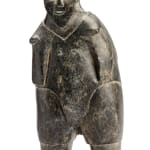-
Artworks
FRANCIS KALURAQ (1931-1990) QAMANI'TUAQ (BAKER LAKE)
Standing Mother and Child, c. 1963-64stone, 13.5 x 6.5 x 4.25 in (34.3 x 16.5 x 10.8 cm)
apparently unsigned.Further images
Francis Kaluraq was one of the first Baker Lake sculptors singled out for special attention in the early 1960s. Sculptures by him were reproduced in both books by George Swinton...Francis Kaluraq was one of the first Baker Lake sculptors singled out for special attention in the early 1960s. Sculptures by him were reproduced in both books by George Swinton and elsewhere. Perhaps his most famous work is a massive, blocky Hunter with a raised fishing spear from 1964 formerly in the Budd Feheley Collection [1], which has been compared to Akeeaktashuk’s iconic hunters (see Lot 10). Equally important, and more relevant to this masterpiece, are Kaluraq’s contemporaneous and imposing figures of women [2]. Although Kaluraq was never a prolific sculptor and switched to printmaking in the 1970s before retiring from art making altogether, his works from the early 1960s must have been highly influential for they more closely resemble what we now think of as the “classic” Baker Lake sculptural style of the early-mid 1970s than those of his early peers.
Kaluraq’s sculptures are immediately recognizable for their relatively large scale, their bulky, sometimes blocky proportions, and their broad, flattened facial features with highly distinctive forehead and nose that are shaped remarkably like an ulu blade and handle! Standing Mother and Child is a particularly fine work by this artist; her proportions are sturdy but not blocky; the faces of mother and child are carved simply but with finesse - and we love the mother’s smiling mouth and eyes which counter the severity of her brow and chin. Her v-neckline frames that impressive chin, and just below it are diamond shapes that suggest nipples but in fact represent ivory or antler toggles. Seen from the side, the slightly forward-tilting figure appears almost delicate, with lovely crisp lines defining her arms, hood, and hemlines.
1. See Swinton, Eskimo Sculpture, 1965, p. 100.
2. See Ibid., p. 93; George Swinton, Sculpture of the Inuit, 1972/92), fig. 684; Sculpture / Inuit, 1971, cat. 259; and von Finckenstein, Celebrating Inuit Art, 1999, p. 166.
References: Similar work in Canadian Eskimo Arts Council, Sculpture / Inuit: Masterworks of the Canadian Arctic, (Toronto: University of Toronto Press, 1971), cat. 259; Similarly styled works by the artist in George Swinton, Eskimo Sculpture, (Toronto: McClelland and Stewart, Ltd., 1965), pp. 93, 100; George Swinton, Sculpture of the Inuit, (Toronto: McClelland & Stewart, 1972/92), fig. 684. For a somewhat later similar work by the artist in the National Gallery of Canada Collection see Susan Gustavison, Northern Rock: Contemporary Inuit Stone Sculpture, (Kleinburg: McMichael Canadian Art Collection, 1999), cat. 36. See Woman on One Knee in the Jerry Twomey Collection at the WAG - see Darlene Coward Wight, The Jerry Twomey Collection, (Winnipeg: Winnipeg Art Gallery, 2003), cat. 20. See a similar Woman from c. 1964 in Maria von Finckenstein ed., Celebrating Inuit Art 1948-1970, (Hull, QC: Canadian Museum of Civilization, 1999), p. 166; Twelve sculptures by Kaluraq were included in the 1964 exhibition Eskimo Carvers of Keewatin N.W.T., exh. cat., (s.l. [Winnipeg], s.n. [Winnipeg Art Gallery?, 1964) with two illustrated in the catalogue, pp. 29-30. For a Standing Figure with Four Faces by the artist see Walker’s Auctions, Ottawa, 13 November 2011, Lot 109.Provenance
Canadian Private Collection;
Waddington’s Auctions, Toronto, November 2000, Lot 61;
Collection of John and Joyce Price, Seattle.
Join our mailing list
* denotes required fields
We will process the personal data you have supplied in accordance with our privacy policy (available on request). You can unsubscribe or change your preferences at any time by clicking the link in our emails.










